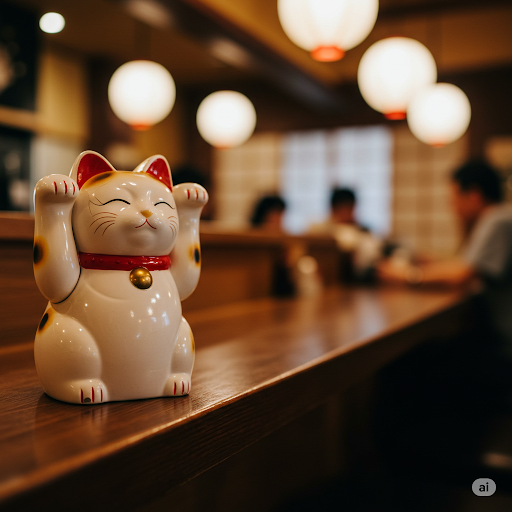
The Waving Paw of Fortune: Unraveling the Origins of the Maneki-Neko
Share
The Waving Paw of Fortune: Unraveling the Origins of the Maneki-Neko
Few Japanese cultural symbols are as instantly recognizable as the Maneki-Neko, the adorable beckoning cat with one paw raised. From the windows of ramen shops to the shelves of gift stores worldwide, this charming feline has become synonymous with good luck and prosperity. But where did this ubiquitous symbol come from? Like many enduring traditions, the exact origins are a bit shrouded in legend, but several fascinating tales point to its humble beginnings in Edo-period Japan.
A Cat of Many Legends: The Most Popular Theories
While no single definitive "eureka!" moment exists, three prominent stories repeatedly surface when discussing the birth of the Maneki-Neko:
1. The Gōtoku-ji Temple Legend: The Rags to Riches Tale
Perhaps the most famous and widely accepted origin story traces back to the Gōtoku-ji Temple in Setagaya, Tokyo. The tale goes that during the Edo period (17th century), a poor monk lived with his cat, Tama, at the dilapidated temple. One day, a wealthy feudal lord, Ii Naotaka, was caught in a sudden thunderstorm while hunting. He took shelter under a large tree near the temple.
As the storm raged, the lord noticed Tama, the monk's cat, sitting at the temple gate, seemingly beckoning him inside with a raised paw. Curious, the lord followed the cat into the temple. Moments later, lightning struck the tree where he had just been sheltering. Realizing the cat had saved his life, Lord Ii Naotaka became a benefactor of the temple, which subsequently flourished.
In gratitude for Tama's actions, the temple was dedicated to the cat, and when Tama passed away, the first Maneki-Neko statues were supposedly made in his honor. To this day, Gōtoku-ji Temple is filled with thousands of Maneki-Neko offerings from visitors, a testament to this enduring legend.
2. The Courtesan and Her Cat: A Misunderstood Gesture
Another captivating, albeit darker, legend involves a geisha or courtesan in Yoshiwara (Edo's pleasure district). This tale suggests that her beloved cat constantly tugged at her kimono. One night, a shop owner, believing the cat was possessed or trying to bewitch her, drew his sword and decapitated the feline. The cat's head reportedly flew through the air and landed directly on a venomous snake that was about to strike the courtesan, killing the snake and saving her life.
Devastated by her cat's death, but also relieved to have been saved, the courtesan mourned deeply. A customer, feeling sympathy, commissioned an artist to create a wooden statue of her beloved cat in its beckoning pose. This became the first Maneki-Neko. While less "lucky" in its immediate origin, it highlights the cat's protective spirit.
3. The Old Woman and Her Lucky Cat: A Dream of Prosperity
A simpler, yet equally charming, story tells of an impoverished old woman in Imado (a district known for pottery). Desperate, she had to sell her beloved cat to survive. Soon after, her cat appeared to her in a dream, telling her to make a doll in its image. The woman followed the dream's instruction, creating a cat figurine with a raised paw. She then placed it outside her home.
Miraculously, passersby were drawn to the unique figurine and began buying them. The woman's fortune turned around, and the Maneki-Neko began its journey as a symbol of attracting customers and good business. The Imado Jinja shrine in Tokyo is also associated with the Maneki-Neko, with some believing it was the birthplace of the ceramic version.
The Evolution of the Waving Paw
Regardless of which legend holds the most historical truth, the Maneki-Neko began to appear more widely during the late Edo period and early Meiji era. Early versions were often made of ceramic, particularly from kilns in Imado. Over time, variations emerged:
- Which Paw is Raised? A common question! A right paw raised is typically believed to invite money and good fortune, while a left paw raised is said to attract customers and people. Some statues even have both paws raised for double the luck!
- The Coin: The coin held by many Maneki-Neko is usually a koban, an old Japanese gold coin from the Edo period, signifying wealth.
- The Bib and Bell: These are often seen as symbols of a treasured pet and prosperity.
More Than Just a Cute Figurine
Today, the Maneki-Neko is more than just a decorative item; it's a deeply ingrained part of Japanese folk belief and a global ambassador of good luck. Its welcoming paw is a reminder of the power of serendipity, the protective spirit of animals, and the enduring hope for prosperity. So, the next time you see a Maneki-Neko, remember the rich tapestry of legends that led to its creation – a true testament to the enchanting power of a lucky cat.
